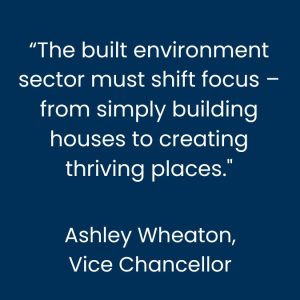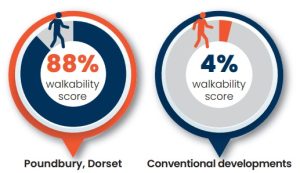Reduce obesity and live longer – the call for ‘healthy neighbourhoods’
Posted on: 27 August, 2025

Designing neighbourhoods around people rather than just houses is combatting childhood obesity, lowering hospital admissions and even extending life expectancy, according to a new report from the University of the Built Environment. Schools in these neighbourhoods also consistently outperform local averages, while crime rates are significantly lower.
The link between place building and public health
 At the University’s recent INSPIRE (INfluence for Skills, Productivity, Industry, Research & Education) event, Dr William Bird MBE, CEO of Intelligent Health, underlined the link between place building and public health. He stressed that thoughtful community design directly shapes outcomes – encouraging physical activity, social interaction and engagement with nature, while boosting overall wellbeing.
At the University’s recent INSPIRE (INfluence for Skills, Productivity, Industry, Research & Education) event, Dr William Bird MBE, CEO of Intelligent Health, underlined the link between place building and public health. He stressed that thoughtful community design directly shapes outcomes – encouraging physical activity, social interaction and engagement with nature, while boosting overall wellbeing.
Supporting this, Dan Hill, Research Analyst at Savills, presented findings from a joint Savills–University of the Built Environment study of 71 new housing developments across the UK. Each was assessed using a comprehensive ‘place score’ covering factors such as green space, community infrastructure, amenities and retail provision. Developments with higher scores recorded markedly better outcomes: lower childhood obesity rates, fewer emergency hospital admissions, reduced premature mortality, stronger educational results and lower crime.
Ashley Wheaton, Vice Chancellor of the University of the Built Environment, said: “The built environment sector must shift focus – from simply building houses to creating thriving places. This report shows that by committing to long-term placemaking, engaging communities and embracing innovation, we can tackle the housing crisis in a way that delivers lasting social value.”
Poor housing costs the NHS an estimated £1.4 billion
Keynote speaker Dr Wei Yang OBE, immediate past Chair of the Construction Industry Council, highlighted the scale of England’s housing challenge. More than 100,000 households – including 164,000 children – are currently living in temporary accommodation, she said, while poor housing costs the NHS an estimated £1.4 billion each year. Dr Yang argued that one-size-fits-all solutions are inadequate, calling for a strategic, long-term, place-based approach.
 Ben Bolgar MVO, Executive Director of Projects at model – helping smaller builders form consortia and deliver communities distinct from volume housebuilders, which he described as often monocultural and car-dependent.
Ben Bolgar MVO, Executive Director of Projects at model – helping smaller builders form consortia and deliver communities distinct from volume housebuilders, which he described as often monocultural and car-dependent.
As an example, he cited Poundbury in Dorset, a Duchy of Cornwall development that achieved an 88% walkability score compared with 4% in conventional schemes. “For over 30 years, The King’s Foundation has pioneered holistic community development,” he said. “By fostering stewardship and high-quality design, we can build communities that are not only sustainable and beautiful, but also socially and economically vibrant.”
Four key recommendations
The report sets out four key recommendations: embedding health and sustainability into design, introducing fiscal reforms to incentivise stewardship, scaling up regional delivery hubs, and ensuring genuine community involvement in design.
The University argues that by adopting these principles, developers and policymakers can create neighbourhoods that are not only attractive places to live but also healthier, safer and more resilient.
The full report, ‘Place Building: Developing Homes & Communities’, is available to download here (PDF).



